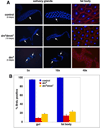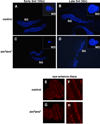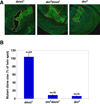Drosophila growth and development in the absence of dMyc and dMnt
- PMID: 18241851
- PMCID: PMC2322934
- DOI: 10.1016/j.ydbio.2007.12.026
Drosophila growth and development in the absence of dMyc and dMnt
Abstract
Myc oncoproteins are essential regulators of the growth and proliferation of mammalian cells. In Drosophila the single ortholog of Myc (dMyc), encoded by the dm gene, influences organismal size and the growth of both mitotic and endoreplicating cells. A null mutation in dm results in attenuated endoreplication and growth arrest early in larval development. Drosophila also contains a single ortholog of the mammalian Mad/Mnt transcriptional repressor proteins (dMnt), which is thought to antagonize dMyc function. Here we show that animals lacking both dMyc and dMnt display increased viability and grow significantly larger and develop further than dMyc single mutants. We observe increased endoreplication and growth of larval tissues in these double mutants and disproportionate growth of the imaginal discs. Gene expression analysis indicates that loss of dMyc leads to decreased expression of genes required for ribosome biogenesis and protein synthesis. The additional loss of dMnt partially rescues expression of a small number of dMyc and dMnt genes that are primarily involved in rRNA synthesis and processing. Our results indicate that dMnt repression is normally overridden by dMyc activation during larval development. Therefore the severity of the dm null phenotype is likely due to unopposed repression by dMnt on a subset of genes critical for cell and organismal growth. Surprisingly, considerable growth and development can occur in the absence of both dMyc and dMnt.
Figures






Similar articles
-
dMyc is required for larval growth and endoreplication in Drosophila.Development. 2004 May;131(10):2317-27. doi: 10.1242/dev.01108. Development. 2004. PMID: 15128666
-
The transcriptional repressor dMnt is a regulator of growth in Drosophila melanogaster.Mol Cell Biol. 2005 Aug;25(16):7078-91. doi: 10.1128/MCB.25.16.7078-7091.2005. Mol Cell Biol. 2005. PMID: 16055719 Free PMC article.
-
Hfp inhibits Drosophila myc transcription and cell growth in a TFIIH/Hay-dependent manner.Development. 2010 Sep 1;137(17):2875-84. doi: 10.1242/dev.049585. Epub 2010 Jul 28. Development. 2010. PMID: 20667914
-
Metamorphosis in Drosophila: from molecular biology to mutants.Trends Genet. 1995 Sep;11(9):335-6. doi: 10.1016/s0168-9525(00)89099-x. Trends Genet. 1995. PMID: 7482781 Review. No abstract available.
-
Hey bHLH factors in cardiovascular development.Cold Spring Harb Symp Quant Biol. 2002;67:63-70. doi: 10.1101/sqb.2002.67.63. Cold Spring Harb Symp Quant Biol. 2002. PMID: 12858525 Review. No abstract available.
Cited by
-
Evidence for tissue-specific Jak/STAT target genes in Drosophila optic lobe development.Genetics. 2013 Dec;195(4):1291-306. doi: 10.1534/genetics.113.155945. Epub 2013 Sep 27. Genetics. 2013. PMID: 24077308 Free PMC article.
-
Myc function in Drosophila.Cold Spring Harb Perspect Med. 2013 Oct 1;3(10):a014324. doi: 10.1101/cshperspect.a014324. Cold Spring Harb Perspect Med. 2013. PMID: 24086064 Free PMC article. Review.
-
Drosophila Myc integrates multiple signaling pathways to regulate intestinal stem cell proliferation during midgut regeneration.Cell Res. 2013 Sep;23(9):1133-46. doi: 10.1038/cr.2013.101. Epub 2013 Jul 30. Cell Res. 2013. PMID: 23896988 Free PMC article.
-
Interspecies analysis of MYC targets identifies tRNA synthetases as mediators of growth and survival in MYC-overexpressing cells.Proc Natl Acad Sci U S A. 2019 Jul 16;116(29):14614-14619. doi: 10.1073/pnas.1821863116. Epub 2019 Jul 1. Proc Natl Acad Sci U S A. 2019. PMID: 31262815 Free PMC article.
-
Systemic changes in cell size throughout the body of Drosophila melanogaster associated with mutations in molecular cell cycle regulators.Sci Rep. 2023 May 9;13(1):7565. doi: 10.1038/s41598-023-34674-y. Sci Rep. 2023. PMID: 37160985 Free PMC article.
References
-
- Adhikary S, Eilers M. Transcriptional regulation and transformation by Myc proteins. Nat Rev Mol Cell Biol. 2005;6:635–645. - PubMed
-
- Adhikary S, et al. The Ubiquitin Ligase HectH9 Regulates Transcriptional Activation by Myc and Is Essential for Tumor Cell Proliferation. Cell. 2005;123:409–421. - PubMed
-
- Al-Shahrour F, et al. FatiGO: a web tool for finding significant associations of Gene Ontology terms with groups of genes. Bioinformatics. 2004;20:578–580. - PubMed
-
- Amati B, et al. Function of the c-Myc oncoprotein in chromatin remodeling and transcription. Biochim. Biophys. Acta. 2001;1471:M135–M145. - PubMed
-
- Amati B, Land H. Myc-Max-Mad: a transcription factor network controlling cell cycle progression, differentiation and death. Current Opinion Genetics & Development. 1994;4:102–108. - PubMed
Publication types
MeSH terms
Substances
Grants and funding
LinkOut - more resources
Full Text Sources
Molecular Biology Databases

